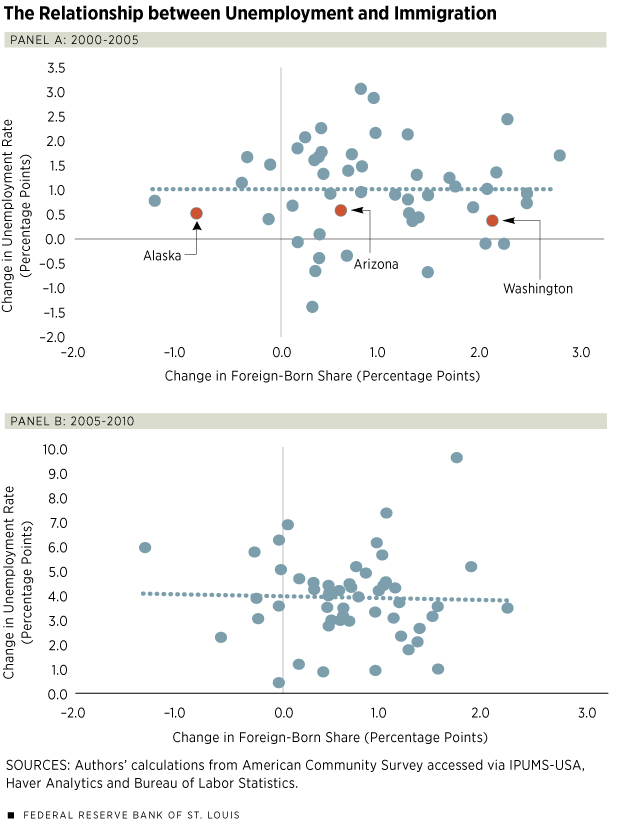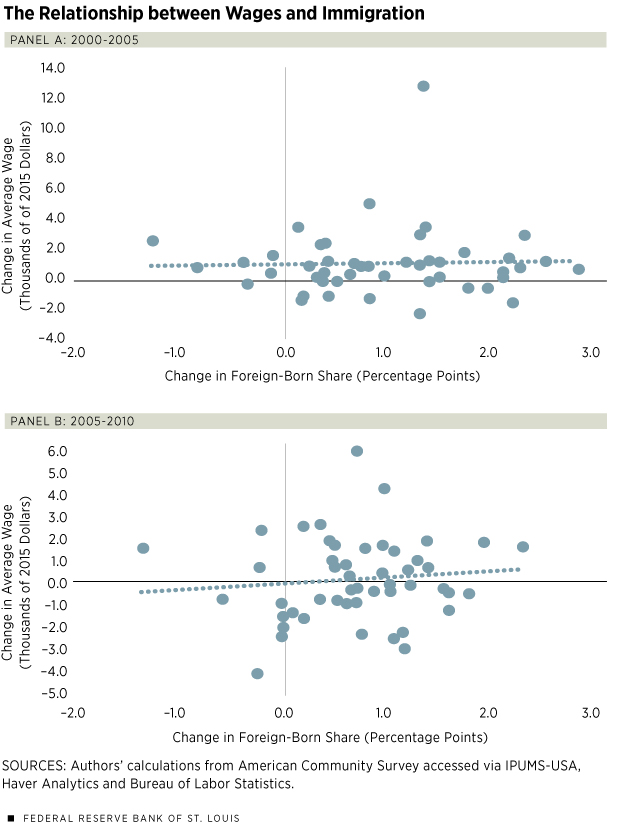Mixing the Melting Pot: The Impact of Immigration on Labor Markets
Immigration to the United States is at the center of many debates. The issue is not new, not only in the U.S. but in many other parts of the world, as evidenced in the many discussions in the media, as well as in political and academic circles. For this paper, we looked at U.S. data across states to assess the connection between immigration and labor market outcomes. We were prompted by the argument that immigrants make life harder for workers who already are U.S. citizens. Specifically, we investigated the correlation between immigration and the unemployment rate and between immigration and wages.
We used state-level data from the U.S. Census Bureau for the years 2000, 2005 and 2010 for wages and immigration figures. Immigrants are defined as those who are foreign-born.1 For wages, we used inflation-adjusted pretax wages and salary incomes of the employed population between the ages of 18 and 60. Finally, we used the Bureau of Labor Statistics’ seasonally adjusted unemployment rate.
Immigration and Unemployment
Does a change in immigration affect the unemployment rate? An answer to this question can be found in Figure 1, Panel A. It shows how changes in the proportion of foreign-born are associated with changes in the rate of unemployment from 2000 to 2005. Each point represents a state. This panel assesses whether states with changes in their proportion of foreign-born tend to see systematic change in their rate of unemployment.
A closer look at three states may help explain the panel. Take Alaska first. Between 2000 and 2005, the proportion of foreign-born among the total population decreased from 7.5 to 6.7 percent, a difference of –0.8 percentage point (measured on the horizontal axis). During the same period, the rate of unemployment rose from 6.4 to 6.9 percent of the labor force, a difference of 0.5 percentage point (measured on the vertical axis). Turn now to Arizona and Washington state. Like Alaska, they too experienced an increase in their unemployment rate of about 0.5 percentage point. But, unlike Alaska, the proportion of immigrants in these states increased, by 0.6 percentage point for Arizona and by 2.1 percentage points for Washington.
Considering these three states only, similar changes in labor market conditions—namely an increase in the rate of unemployment—are associated with very different changes in the proportion of immigrants. This suggests a weak correlation between the two variables. The remaining states plotted on Panel A of Figure 1 convey the same message.
Had there been a strong relationship between the foreign-born proportion and the unemployment rate, this panel would have displayed it via a clear alignment of points along a line or a curve, and we would have concluded that the correlation between the variables was close to 100 percent. Instead, analyzing the data in Panel A of Figure 1 reveals a correlation that is less than 0.1 percent. There appears to be no statistical link between unemployment and immigration.2
Does this result depend upon the period under consideration? Panel B of Figure 1 shows the relationship between unemployment and immigration between 2005 and 2010. Note that unemployment rates increased much more in all the states than they did during the 2000-2005 period. This is the effect of the Great Recession, which started in 2007 and ended in 2009. Like Panel A, Panel B of Figure 1 reveals that the relationship between unemployment and immigration is weak to nonexistent, even during this crisis period.
Immigration and Wages
If immigration does not affect employment opportunities, maybe it matters for the wage rate. Again, we turn to state-level census data to examine whether a state with an increasing proportion of those who are foreign-born has systematically experienced higher or lower wages over time.
Panel A of Figure 2 presents the relationship between wages and immigration between 2000 and 2005. Like Panel A of Figure 1, this panel reveals a weak to nonexistent correlation. Specifically, changes in the level of wages are very similar across states (i.e., they line up along a horizontal line) even though changes in the proportion of foreign-born people vary a lot.
Panel B of Figure 2 shows, as Panel B of Figure 1 did for unemployment, that the correlation between wages and immigration remains nonexistent during the crisis period.
Immigration and Low-Skilled Workers
Figures 1 and 2 show that there is no connection between immigration and the labor market outcomes (unemployment risk and wage) of the average worker. But what about more narrowly defined groups of workers? Is it possible, for example, that an influx of low-skilled immigrants mostly affects the labor market outcomes of low-skilled native workers?
A study by economist David Card addresses this question. It discusses the consequences of the Mariel boatlift episode, when about 125,000 Cubans emigrated from Cuba's Mariel port to Miami between May and September 1980. These immigrants had relatively low skills (i.e., less than the average Cuban worker). Card found no evidence that low-skilled wages and the unemployment rate among low-skilled workers changed in Miami.
Conclusion
There have been many studies of the economic consequences of immigration, and they do not all agree. Findings are sometimes specific to the experiment at hand, as in the Mariel boatlift case, where it could be argued that the Miami labor market is not representative of the U.S. as a whole.
Yet, it remains that many studies find little to no evidence of a connection between immigration and labor market outcomes.3 Since this may be more surprising, on the surface, than the opposite result, it deserves some explanations. One possible explanation is that some immigrants may have overall positive effects on the economy. This would be especially true of high-skilled immigrants who contribute ideas and innovations that drive productivity higher. Another explanation is that, even in the same skill group, immigrants and native workers may not be perfect substitutes. It was suggested in one study that immigrants do not so much compete directly with natives as they create conditions for increased specialization by which natives perform more communication-intensive work and immigrants do manual tasks.4
Guillaume Vandenbroucke is an economist, and Heting Zhu is a research associate, both at the Federal Reserve Bank of St. Louis. For more on Vandenbroucke’s work, see https://research.stlouisfed.org/econ/vandenbroucke.


Endnotes
- When surveyed for the census, respondents are expected to reveal the birthplace of each of the members in their households, specifying the state or country of origin. [back to text]
- The dotted line in the figure represents, graphically, the statistical relationship between the variables measured on the vertical and horizontal axes. The fact that this line is flat is another way to express the lack of correlation between the variables. [back to text]
- See Basso and Peri. [back to text]
- Ibid., p.15. [back to text]
References
Basso, Gaetano; and Peri, Giovanni. “The Association between Immigration and Labor Market Outcomes in the United States.” Discussion Paper No. 9436. Institute of Labor Economics (IZA), 2015.
Card, David. “The Impact of the Mariel Boatlift on the Miami Labor Market.” Industrial and Labor Relations Review, January 1990, Vol. 43, No. 2, pp. 245-57.
IPUMS-USA (Integrated Public Use Microdata Series). University of Minnesota. See www.ipums.org.
Views expressed in Regional Economist are not necessarily those of the St. Louis Fed or Federal Reserve System.
For the latest insights from our economists and other St. Louis Fed experts, visit On the Economy and subscribe.
Email Us



